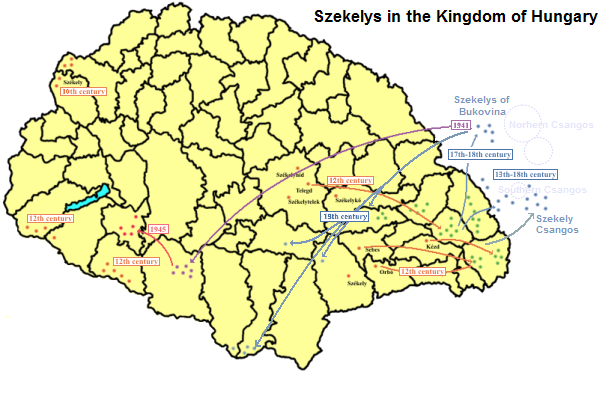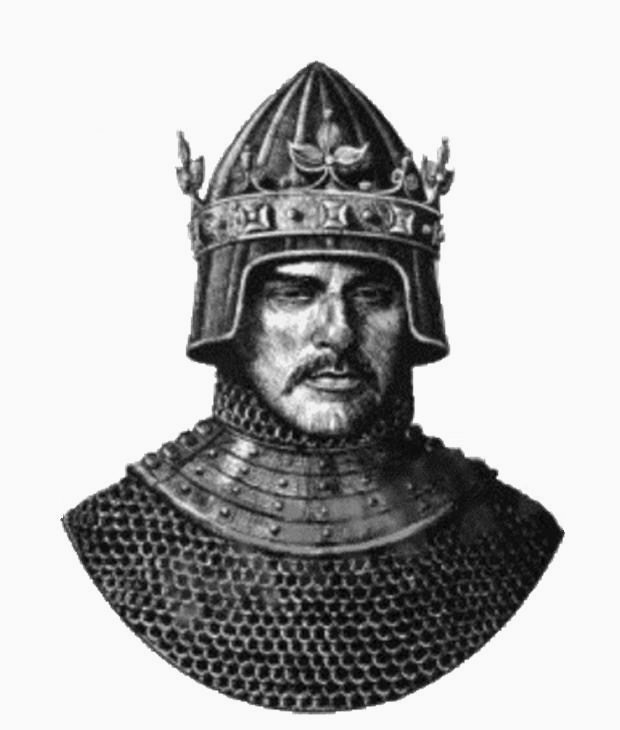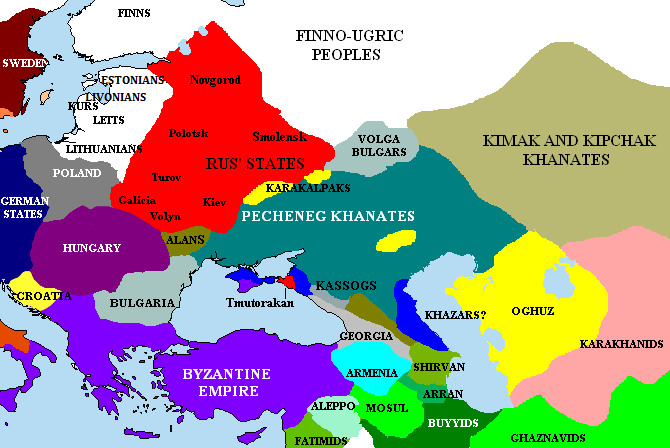|
Count Of The Székelys
The Count of the Székelys ( hu, székelyispán, la, comes Sicolorum) was the leader of the Hungarian-speaking Székelys in Transylvania, in the medieval Kingdom of Hungary. First mentioned in royal charters of the 13th century, the counts were the highest-ranking royal officials in Székely Land. From around 1320 to the second half of the 15th century, the counts' jurisdiction included four Transylvanian Saxon districts, in addition to the seven Székely seats (or administrative units). The counts also held important castles outside the territories under their administration, including their seat at Görgény (now Gurghiu in Romania). They were the supreme commanders of the Székely troops; their military campaigns against Bulgaria and the Golden Horde were mentioned in royal charters and medieval chronicles. The counts presided over the general assemblies of both the individual Székely seats and the entire Székely community. They also heard appeals of the decisions of the ... [...More Info...] [...Related Items...] OR: [Wikipedia] [Google] [Baidu] |
Székelys
The Székelys (, Székely runes: 𐳥𐳋𐳓𐳉𐳗), also referred to as Szeklers,; ro, secui; german: Szekler; la, Siculi; sr, Секељи, Sekelji; sk, Sikuli are a Hungarian subgroup living mostly in the Székely Land in Romania. A significant population descending from the Székelys of Bukovina lives in Tolna and Baranya counties in Hungary and certain districts of Vojvodina, Serbia. In the Middle Ages, the Székelys played a role in the defense of the Kingdom of Hungary against the Ottomans in their posture as guards of the eastern border. With the Treaty of Trianon of 1920, Transylvania (including the Székely Land) became part of Romania, and the Székely population was a target of Romanianization efforts. In 1952, during the communist rule of Romania, the former counties with the highest concentration of Székely population – Mureș, Odorhei, Ciuc, and Trei Scaune – were legally designated as the Magyar Autonomous Region. It was superseded in ... [...More Info...] [...Related Items...] OR: [Wikipedia] [Google] [Baidu] |
Transylvanian Saxons
The Transylvanian Saxons (german: Siebenbürger Sachsen; Transylvanian Saxon: ''Siweberjer Såksen''; ro, Sași ardeleni, sași transilvăneni/transilvani; hu, Erdélyi szászok) are a people of German ethnicity who settled in Transylvania (german: Siebenbürgen) in waves starting from the mid- 12th century until the mid 19th century. The legal foundation of the settlement was laid down in the Diploma Andreanum issued by King Andrew II of Hungary that is known for providing the first territorial autonomy hitherto in the history. The Transylvanian "Saxons" originally came from Flanders, Hainaut, Brabant, Liège, Zeeland, Moselle, Lorraine, and Luxembourg, then situated in the north-western territories of the Holy Roman Empire around the 1140s. After 1918 and the dissolution of Austria-Hungary, in the wake of the Treaty of Trianon, Transylvania united with the Kingdom of Romania. Consequently, the Transylvanian Saxons, together with other ethnic German sub-groups in ... [...More Info...] [...Related Items...] OR: [Wikipedia] [Google] [Baidu] |
Lack Hermán
Lack from the kindred Hermán ( hu, Hermán nembeli Lack), also known as Lack of Kerekegyháza ( hu, Kerekegyházi Lack; died 1359) was an influential Hungarian nobleman, who served as Count of the Székelys from 1328 to 1343. He was the eponymous ancestor of the powerful and rich Lackfi family. Ancestry and early life Lack (or Ladislaus) was born into the ''gens'' (clan) Hermán as the son of Denis, whose ancestors are unknown, as a result there is inability to connect the Lackfi branch to the other branches of the clan. According to Simon Kézai's '' Gesta Hunnorum et Hungarorum'', the ancestor of the kindred, knight Herman originated from Nuremberg, who escorted Gisela of Bavaria in 996, who became the wife of Stephen I of Hungary, the future first King of Hungary. Following that Herman received land donations in Vas County. Both ''magister'' Simon and the 14th-century '' Illuminated Chronicle'' described the Hermán kindred as "relatively poor". It is possible that Rubin ... [...More Info...] [...Related Items...] OR: [Wikipedia] [Google] [Baidu] |
Nagyváty
Nagyváty is a village in Baranya county, Hungary Hungary ( hu, Magyarország ) is a landlocked country in Central Europe. Spanning of the Carpathian Basin, it is bordered by Slovakia to the north, Ukraine to the northeast, Romania to the east and southeast, Serbia to the south, Croa .... Populated places in Baranya County {{Baranya-geo-stub ... [...More Info...] [...Related Items...] OR: [Wikipedia] [Google] [Baidu] |
Béla IV Of Hungary
Béla IV (1206 – 3 May 1270) was King of Hungary and Croatia between 1235 and 1270, and Duke of Styria from 1254 to 1258. As the oldest son of King Andrew II, he was crowned upon the initiative of a group of influential noblemen in his father's lifetime in 1214. His father, who strongly opposed Béla's coronation, refused to give him a province to rule until 1220. In this year, Béla was appointed Duke of Slavonia, also with jurisdiction in Croatia and Dalmatia. Around the same time, Béla married Maria, a daughter of Theodore I Laskaris, Emperor of Nicaea. From 1226, he governed Transylvania as duke. He supported Christian missions among the pagan Cumans who dwelled in the plains to the east of his province. Some Cuman chieftains acknowledged his suzerainty and he adopted the title of King of Cumania in 1233. King Andrew died on 21 September 1235 and Béla succeeded him. He attempted to restore royal authority, which had diminished under his father. For this purpose, he ... [...More Info...] [...Related Items...] OR: [Wikipedia] [Google] [Baidu] |
Sibiu
Sibiu ( , , german: link=no, Hermannstadt , la, Cibinium, Transylvanian Saxon: ''Härmeschtat'', hu, Nagyszeben ) is a city in Romania, in the historical region of Transylvania. Located some north-west of Bucharest, the city straddles the Cibin River, a tributary of the river Olt. Now the capital of the Sibiu County, between 1692 and 1791 and 1849–65 Sibiu was also the capital of the Principality of Transylvania. Nicknamed ''The City with Eyes'', the city is a well-known tourist destination for both domestic and foreign visitors. Known for its culture, history, gastronomy and diverse architecture, which includes the iconic houses with eyes that gave Sibiu its nickname, the city has garnered significant attention since the beginning of the 21st century. In 2004, its historical center began the process of becoming a UNESCO World Heritage Site. Sibiu was designated the European Capital of Culture in 2007. One year later, it was ranked "Europe's 8th-most idyllic place to l ... [...More Info...] [...Related Items...] OR: [Wikipedia] [Google] [Baidu] |
Count Of Hermannstadt
The Count of Hermannstadt, also Count of Sibiu or Count of Szeben ( hu, szebeni ispán), was the head of the Transylvanian Saxons living in the wider region of Hermannstadt Sibiu ( , , german: link=no, Hermannstadt , la, Cibinium, Transylvanian Saxon: ''Härmeschtat'', hu, Nagyszeben ) is a city in Romania, in the historical region of Transylvania. Located some north-west of Bucharest, the city straddles the Cib ... (now Sibiu in Romania) in the 13th and early 14th centuries. The counts were royal officials, appointed and dismissed by the Kings of Hungary. Origins Jurisdiction List of the Counts of Hermannstadt Thirteenth century Fourteenth century References Sources * * * * Hungarian noble titles Rulers of Transylvania Medieval Transylvania {{Romania-hist-stub ... [...More Info...] [...Related Items...] OR: [Wikipedia] [Google] [Baidu] |
Joachim Türje
Joachim from the kindred Türje ( hu, Türje nembeli Joachim, also Ivachin or Iwachin) was a Hungarian nobleman and soldier in the first half of the 13th century. He served as the first known Count of Hermannstadt around 1210. Joachim was the forefather of the Szentgróti noble family. Family Joachim was born into the illustrious ''gens'' Türje, which originated from Zala County. His father Gecse I, was the first known member of the kindred. He had at least three siblings: Denis I, the father of the powerful baron Denis II, Gecse II, who served as ''ispán'' of Zala (1225) and Bars counties (1236–1240). An unidentified sister was also mentioned in 1254, when she was widow of a deceased male member of the ''gens'' Ákos. Joachim had two sons from his unidentified wife: Thomas participated in the Battle of Mohi, and later functioned as the ''ispán'' of Karakó ispánate. The Szentgróti family descended from him. Joachim's younger son was Philip, an influential prelate i ... [...More Info...] [...Related Items...] OR: [Wikipedia] [Google] [Baidu] |
Vlachs
"Vlach" ( or ), also "Wallachian" (and many other variants), is a historical term and exonym used from the Middle Ages until the Modern Era to designate mainly Romanians but also Aromanians, Megleno-Romanians, Istro-Romanians and other Eastern Romance-speaking subgroups of Central and Eastern Europe. As a contemporary term, in the English language, the Vlachs are the Balkan Romance-speaking peoples who live south of the Danube in what are now southern Albania, Bulgaria, northern Greece, North Macedonia, and eastern Serbia as native ethnic groups, such as the Aromanians, Megleno-Romanians and the Timok Romanians. The term also became a synonym in the Balkans for the social category of shepherds, and was also used for non-Romance-speaking peoples, in recent times in the western Balkans derogatively. The term is also used to refer to the ethnographic group of Moravian Vlachs who speak a Slavic language but originate from Romanians. "Vlachs" were initially identified and de ... [...More Info...] [...Related Items...] OR: [Wikipedia] [Google] [Baidu] |
Royal Charter
A royal charter is a formal grant issued by a monarch under royal prerogative as letters patent. Historically, they have been used to promulgate public laws, the most famous example being the English Magna Carta (great charter) of 1215, but since the 14th century have only been used in place of private acts to grant a right or power to an individual or a body corporate. They were, and are still, used to establish significant organisations such as boroughs (with municipal charters), universities and learned societies. Charters should be distinguished from royal warrants of appointment, grants of arms and other forms of letters patent, such as those granting an organisation the right to use the word "royal" in their name or granting city status, which do not have legislative effect. The British monarchy has issued over 1,000 royal charters. Of these about 750 remain in existence. The earliest charter recorded on the UK government's list was granted to the University o ... [...More Info...] [...Related Items...] OR: [Wikipedia] [Google] [Baidu] |
Gyula Kristó
Gyula Kristó (11 July 1939 – 24 January 2004) was a Hungarian historian and medievalist, member of the Hungarian Academy of Sciences. Life Gyula Kristó was born in Orosháza on 11 July 1939. He studied at the József Attila University Szeged between 1957 and 1962. Awards *For the 1300-Year-Old Bulgaria (1981) *Albert Szentgyörgyi Prize (1994) Works *''A vármegyerendszer kialakulása Magyarországon'' he Development of the Counties in Hungary(1988) *''A magyar állam megszületése'' he Birth of the Hungarian State He or HE may refer to: Language * He (pronoun), an English pronoun * He (kana), the romanization of the Japanese kana へ * He (letter), the fifth letter of many Semitic alphabets * He (Cyrillic), a letter of the Cyrillic script called ''He'' in ... Sources * 20th-century Hungarian historians Historians of Hungary Members of the Hungarian Academy of Sciences University of Szeged alumni 1939 births 2004 deaths People from Orosháza ... [...More Info...] [...Related Items...] OR: [Wikipedia] [Google] [Baidu] |
Pechenegs
The Pechenegs () or Patzinaks tr, Peçenek(ler), Middle Turkic: , ro, Pecenegi, russian: Печенег(и), uk, Печеніг(и), hu, Besenyő(k), gr, Πατζινάκοι, Πετσενέγοι, Πατζινακίται, ka, პაჭანიკი, bg, печенеги, pechenegi, bg, печенези, ; sh-Latn-Cyrl, Pečenezi, separator=/, Печенези, la, Pacinacae, Bisseni were a semi-nomadic Turkic ethnic people from Central Asia who spoke the Pecheneg language which belonged to the Oghuz branch of the Turkic language family. Ethnonym The Pechenegs were mentioned as ''Bjnak'', ''Bjanak'' or ''Bajanak'' in medieval Arabic and Persian texts, as ''Be-ča-nag'' in Classical Tibetan documents, and as ''Pačanak-i'' in works written in Georgian. Anna Komnene and other Byzantine authors referred to them as ''Patzinakoi'' or ''Patzinakitai''. In medieval Latin texts, the Pechenegs were referred to as ''Pizenaci'', ''Bisseni'' or ''Bessi''. East Slav ... [...More Info...] [...Related Items...] OR: [Wikipedia] [Google] [Baidu] |






